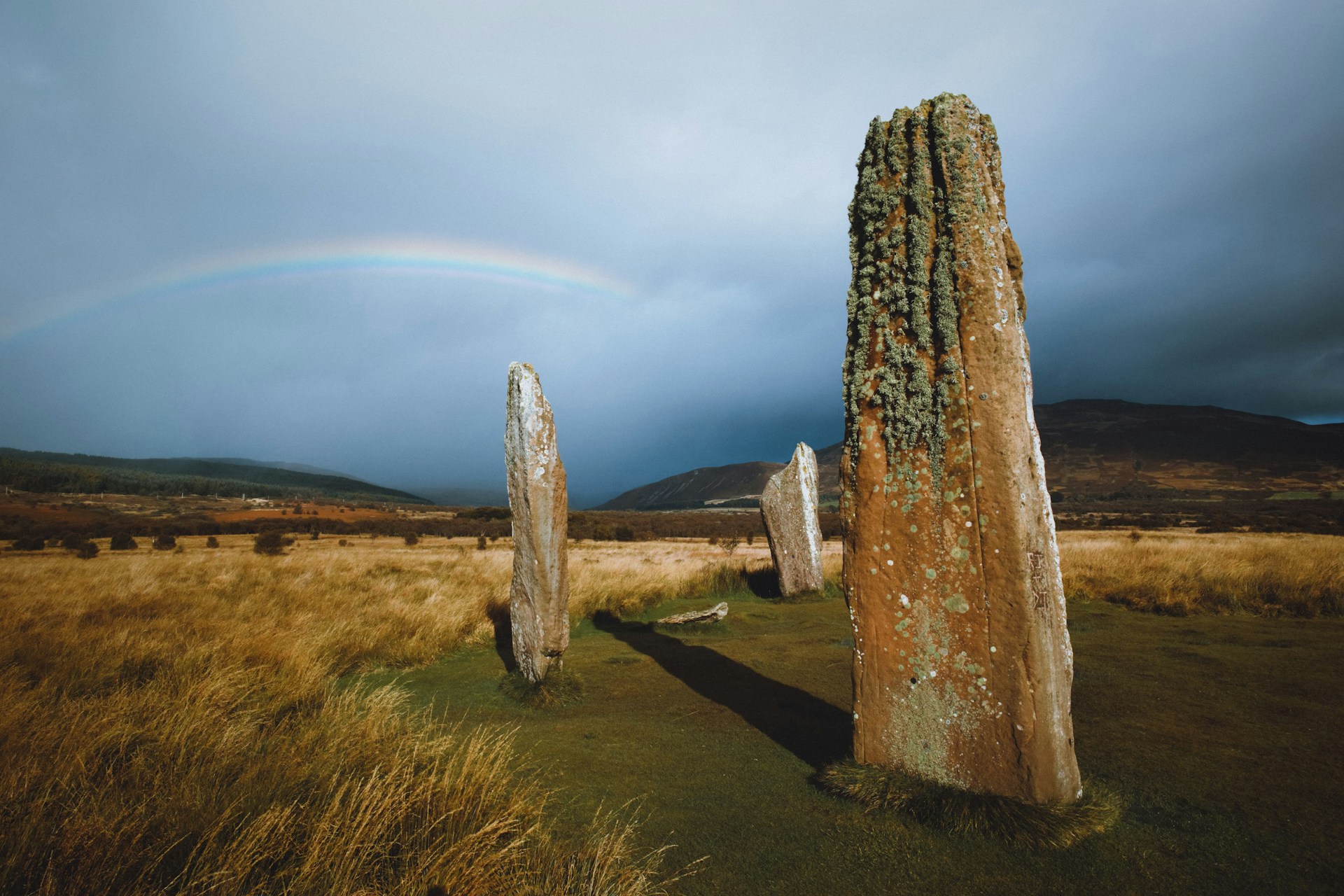This expansive area is home to a collection of stone circles and standing stones, offering a window into Scotland’s Neolithic and Bronze Age past. Machrie Moor is notable for its variety of stone structures, with some circles composed of towering sandstone pillars, while others feature smaller and more modest stones. The site holds great archaeological and cultural significance, reflecting the ritualistic and ceremonial practices of the early communities who lived there.
Historical Background
The stone circles and cairns on Machrie Moor date from approximately 3500 BCE to 1500 BCE, spanning the late Neolithic to the Bronze Age. The area was used for thousands of years by prehistoric peoples for rituals, gatherings, and potentially for funerary purposes. It is believed that the site originally featured timber circles, which were later replaced by stone structures as the community’s rituals evolved.
Archaeological excavations have revealed evidence of human activity across several millennia, including remnants of ancient houses, pottery, and tools. The large stones used in the circles were likely transported over considerable distances, reflecting the effort and importance attached to this sacred landscape.
The Stone Circles of Machrie Moor
There are six primary stone circles on Machrie Moor, each with unique characteristics. They vary in size and construction, ranging from large, upright sandstone and granite slabs to smaller stones set in concentric circles. These circles are often aligned with nearby natural landmarks, such as Arran’s prominent mountains, and may have had astronomical significance, possibly marking solstices or other celestial events.
- Circle 1: This stone circle consists of three large, upright sandstone slabs, each standing about 5 meters tall. The sheer size of these stones makes them one of the most striking features of Machrie Moor.
- Circle 2: A ring of smaller stones, this circle is now largely reduced to a few remaining upright stones, but it is thought to have originally featured more stones set in a concentric arrangement.
- Circle 3: Located nearby, Circle 3 consists of large granite boulders placed in a rough ring, in contrast to the towering sandstone of Circle 1. It shows the variety of construction techniques used by prehistoric builders.
- Circle 5: One of the most complete circles, this one features several upright stones and is surrounded by smaller, lower stones in a concentric formation.
The differing materials and sizes of the stones at Machrie Moor suggest that the site was used by multiple generations and groups, each adding their own stones or reconfiguring existing structures for their rituals or social gatherings.
Rituals and Ceremonies
Although the exact purpose of the stone circles at Machrie Moor remains a mystery, they are widely believed to have been used for ceremonial and religious purposes. Some archaeologists suggest that the site may have been used for ancestral worship or as a gathering place for seasonal festivals. The alignment of some stones with the sun’s position during solstices indicates that they may have functioned as early astronomical markers or calendars.
The area surrounding the circles contains burial cairns, which adds weight to the theory that Machrie Moor had a funerary aspect. These cairns were used for burials and may have been linked to the standing stones through rituals connected to death and the afterlife.
Archaeological Discoveries
Excavations at Machrie Moor have uncovered several intriguing artifacts, including flint tools, pottery, and charred wood. These finds suggest that the site was not just a ceremonial place but also may have been used for domestic or everyday activities at various points in history. The discovery of ancient homes and hearths nearby provides further evidence that the area was a long-term settlement site, rather than a place visited only for special occasions.
One of the most intriguing aspects of Machrie Moor is the presence of cup-and-ring marks, a form of prehistoric rock art found on some of the stones. These carvings, consisting of circular indentations with rings around them, are found at many prehistoric sites across Scotland and the UK, though their meaning remains unclear. Some believe they are symbolic, while others suggest they could be maps or markers of some kind.
Cultural Significance
Machrie Moor continues to captivate visitors for its striking beauty and the mystery surrounding its ancient purpose. In local folklore, the stones are sometimes associated with giants or other supernatural beings, and the site has a mystical reputation. The landscape, with its wide, open moorland and views of Arran’s mountains, adds to the sense of ancient power that many visitors report feeling while exploring the site.
For those interested in Scottish history, archaeology, and ancient spirituality, Machrie Moor is an essential destination. The site is easily accessible via walking trails and is often described as one of the most atmospheric and peaceful locations in Scotland, offering a direct connection to Scotland’s prehistoric past.
Modern Tourism
Today, Machrie Moor is a popular destination for tourists and history enthusiasts. The walking route to the site is relatively easy, and the journey through the surrounding Arran landscape enhances the experience. The site is well-preserved and maintained, allowing visitors to walk among the stones and get a close-up look at this fascinating archaeological landmark.
Machrie Moor provides a unique glimpse into the lives and rituals of ancient peoples, blending the natural beauty of the Isle of Arran with Scotland’s rich prehistoric heritage. Its standing stones continue to inspire awe and curiosity, standing silently as a reminder of a distant past that still shapes the landscape today.


